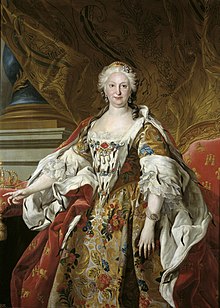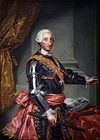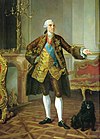Elisabeth Farnese
This article needs additional citations for verification. (October 2010) |
| Elisabeth Farnese | |
|---|---|
 | |
| Queen consort of Spain | |
| Tenure | 24 December 1714 – 14 January 1724 |
| Queen consort of Spain | |
| Tenure | 6 September 1724 – 9 July 1746 |
| Born | 25 October 1692 Palazzo della Pilotta, Parma, Italy |
| Died | 11 July 1766 (aged 73) Royal Palace of Aranjuez, Aranjuez, Spain |
| Burial | 17 July 1766 |
| Spouse | Philip V of Spain |
| Issue Detail | Charles III, King of Spain Mariana Victoria, Queen of Portugal Philip, Duke of Parma Maria Teresa Rafaela, Dauphine of France Luis, Count of Chinchón Maria Antonia Ferdinanda, Queen of Sardinia |
| House | House of Bourbon House of Farnese |
| Father | Odoardo Farnese |
| Mother | Dorothea Sophie of Neuburg |
| Religion | Roman Catholicism |
Elisabeth Farnese (Italian: Elisabetta Farnese, Spanish: Isabel de Farnesio; 25 October 1692 – 11 July 1766), the daughter of Odoardo Farnese and Dorothea Sophie of Neuburg, was Queen consort of Spain who exerted great influence over Spain's foreign policy.
Biography
Parma

Elisabeth was born at the Palazzo della Pilotta in Parma, the capital of a duchy which had been ruled by her family for over two centuries. Elisabeth would later become the heiress of her father's dominions after her uncle Francesco Farnese, Duke of Parma and his younger brother, both of whom remained childless. Victor Amadeus, Prince of Piedmont and Francesco d'Este, Hereditary Prince of Modena had asked for her hand but negotiations failed.
The Duchy of Parma would later be inherited by her first son Infante Carlos, and after his accession to the Spanish throne the title passed on to her third son Infante Felipe. It was he who founded the modern day House of Bourbon-Parma.
Her mother educated her in strict seclusion, but even this measure failed to tame her imperious and ambitious temper.[citation needed] At the age of twenty-one (24 December 1714) she was married by proxy at Parma to Philip V of Spain. The marriage was arranged by Cardinal Alberoni, with the concurrence of the Princesse des Ursins, the Camarera mayor de Palacio of the King of Spain.
Spain
On arriving at the Spanish border, Elizabeth was met by the Princesse des Ursins, but received her sternly, and, perhaps in accordance with a plan previously concerted with the king, at once ordered her removal from her presence and from Spain.[citation needed] Elizabeth quickly obtained complete influence over Philip V, who was considered by all means a weak king. This influence was exerted altogether in support of Alberoni's policy, one chief aim of which was to recover the ancient Italian possessions of Spain, and which actually resulted in the seizure of Sardinia and Sicily. So vigorously did she enter into this policy that, when the French forces advanced to the Pyrenees, she placed herself at the head of one division of the Spanish army.
But Elizabeth's ambition was grievously disappointed. The Triple Alliance thwarted her plans with British troops raiding Vigo, and at length in 1720 the allies made the banishment of Alberoni a condition of peace. Sicily also had to be evacuated and finally all her entreaties failed to prevent the abdication of Philip, who in 1724 gave up the throne in favour of his firstborn heir (from his first marriage), and retired to the palace of La Granja. (Also in 1724, she acquired the San Ildefonso Group for him from the Odescalchi family.)

Seven months later, however, the death of the young king recalled Philip to the throne. During his later years, when he was nearly senile, she directed the whole policy of Spain so as to secure thrones in Italy for her sons. In 1731 she had the satisfaction of seeing her favorite scheme realized with the recognition by the powers in the Treaty of Vienna of her son Don Carlos (afterwards Charles III of Spain) as the Duke of Parma, and after the Treaty of Vienna (1738) his accession to the throne of the Two Sicilies. Her second son, Philip, became Duke of Parma in 1748.
Widowhood
Elizabeth survived her husband by twenty years. In the time between his death in 1746 and her own in 1766, she witnessed many events: the accession to the Spanish throne of her stepson, Ferdinand VI and Barbara of Portugal, whom she hated; and the accession to the throne of Parma of her beloved second son, Philip. In 1752 she built Riofrio Palace as her dowager residence. One year before her death she had the satisfaction of seeing the marriage between her grandson, Charles, Prince of Asturias (future Charles IV), and her granddaugther Maria Luisa of Parma.
She later spent much of her time at the palaces of La Granja and Aranjuez. It was there that she died in 1766 at the age of 73. She was buried next to her husband in the Colegiata of San Ildefonso.
| Family of Elisabeth in 1723 |
|---|
 |
| Family of Elisabeth of Parma in 1743 |
|---|
 |
Issue
| Name | Portrait | Lifespan | Notes | |
|---|---|---|---|---|
| Charles Duke of Parma King of Naples and Sicily King of Spain |

|
20 January 1716 – 14 December 1788 |
was the King of Spain and the Spanish Indes from 1759 to his death in 1788. In 1738 he married the cultured Princess Maria Amalia of Saxony with whom he had 13 children; | |
| Infante Francisco |

|
21 March 1717 – 21 April 1717 |
died in infancy | |
| Infanta Mariana Victoria Queen of Portugal |

|
31 March 1718 – 15 January 1781 |
; was Queen Consort of Portugal and the Algarves due to her marriage to Joseph I. She also acted as Queen Regent of Portugal. | |
| Philip Duke of Parma |

|
20 March 1720 – 18 July 1765 |
Duke of Parma, Plasencia and Guastalla (15 March 1720 – 18 July 1765) was duke of Parma from 1748 to 1765. He founded the house of Bourbon-Parma (a.k.a. the Bourbons of Parma); married Princess Louise Élisabeth of France and had issue. | |
| Infanta Maria Teresa Antonia Rafaela Dauphine of France |

|
11 June 1726 – 22 July 1746 |
was Dauphine of France as spouse of Louis, Dauphin of France. In France, she was known simply as Madame la Dauphine. | |
| Infante Luis Antonio Jaime Count of Chinchón |

|
25 July 1727 – 7 August 1785 |
known as the Cardinal-Infante. Was Archbishop of Toledo, Primate of Spain and Cardinal since 1735. In 1754 renounced his ecclesiastical titles and became Count of Chinchón. In 1776, he married morganatically Doña María Teresa de Vallabriga y Rozas and had issue, but without royal titles. | |
| Infanta Maria Antonia Ferdinanda Queen of Sardinia |

|
17 November 1729 – 19 September 1785 |
was Queen of Sardinia as the wife of King Victor Amadeus III of Sardinia. She was a mother of 3 rulers of Sardinia. |
Ancestry
Sources

- Petrie, Charles: King Charles III of Spain New York, John Day Company, 1971
- Harcourt-Smith, Simon: Cardinal of Spain: the Life and Strange Career of Giulio Alberoni New York, Knopf, 1955
- Mémoires pour servir à l'histoire d'Espagne sous le régne de Philippe V by the Marquis de St Philippe, translated by Maudave (Paris, 1756)
- Memoirs of Elizabeth Farnese (London, 1746)
- Armstrong, E: Elizabeth Farnese, the Termagant of Spain, 1892
- The Spanish original of the Comentarios del marqués de San Felipe was published in the Biblioteca de Autores Españoles.
References
- This article incorporates text from a publication now in the public domain: Chisholm, Hugh, ed. (1911). Encyclopædia Britannica (11th ed.). Cambridge University Press.
{{cite encyclopedia}}: Missing or empty|title=(help)
| Styles of Elisabeth, Queen of Spain as consort | |
|---|---|
 | |
| Reference style | Her Catholic Majesty |
| Spoken style | Your Catholic Majesty |
| Alternative style | Sire |
